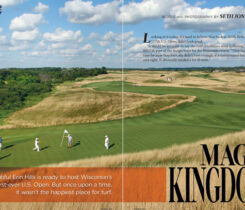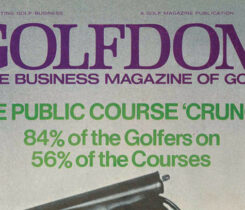The Golfdom Files: What of Golf in 1943?
Here is a round-up of opinion from regional golf association officials based on experiences of 1942.
Officials of regional golf associations have collaborated with Golfdom in taking a cold-eyed look at the facts of life in U.S. golf this first season of global war.
Experiences this year, during which eastern clubs got a preview of the effect gasoline rationing probably will have nationally, gives basis for the belief that at least 1,500 of the 5,209 golf clubs that operated in the spring of 1942 won’t be played on in 1943.
Of the nation’s golf clubs at the start of 1942, there were 2,007 that had one or more 18-hole courses. There were 3,202 9-hole clubs. These clubs were classified as 3,288 private clubs; 1,210 daily-fee courses, and 711 public courses.
Basing our estimates mainly on the maps, we don’t see much chance for about 500 of the 18-hole clubs and 1,000 of the 9-hole clubs to operate in 1943. The public courses probably won’t lose more than 30, and those in the far-out districts of large cities or in state park areas.
But you can make a guess better or worse than ours, and nobody can argue with you, for it all chiefly depends on how the war goes.
The preceding estimates were based on what the evidence has indicated about: (a) how far players will go to play golf; (b) to what extent they’ll share autos or use other transportation; (c) what effect caddie supply has at private clubs; (d) appeal of clubs minus the service to which members have been accustomed; (e) effect of increased taxes.
One thing stands out plainly in this year’s golf and that is the difficulty of many members getting accustomed to lowered service standards and higher prices at private clubs. They’ll get over that.
It is quite logical to expect that the clubs surviving in 1943 will get heavier play than normal, barring exceedingly adverse war conditions. Toward the latter part of this season there were signs that the executive and professional men classes of amateur golfer were beginning to recognize golf as physical- and mental-conditioning recreation, having a high value in balancing the strain of wartime work.
Greater income for wage-earners was reflected in public course play and in fee-course play at closer-in courses. Rainy weather was a retarding element. Nevertheless, preliminary estimates for the 1942 golf season points to public and fee course play being about five percent greater than last year, an increase of about 1,500,000 rounds. Private club play was off about 10 percent from 1941, or approximately 2,000,000 rounds, according to available data. Entire play for the year probably slid a million rounds off the 1941 total. Where the sharp reduction in play at many private clubs occurred was in women’s golf. The women have gone in for war work as intensely as they went in for golf.










